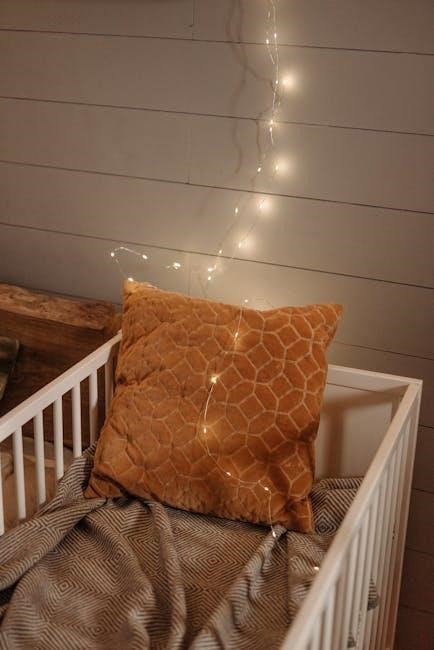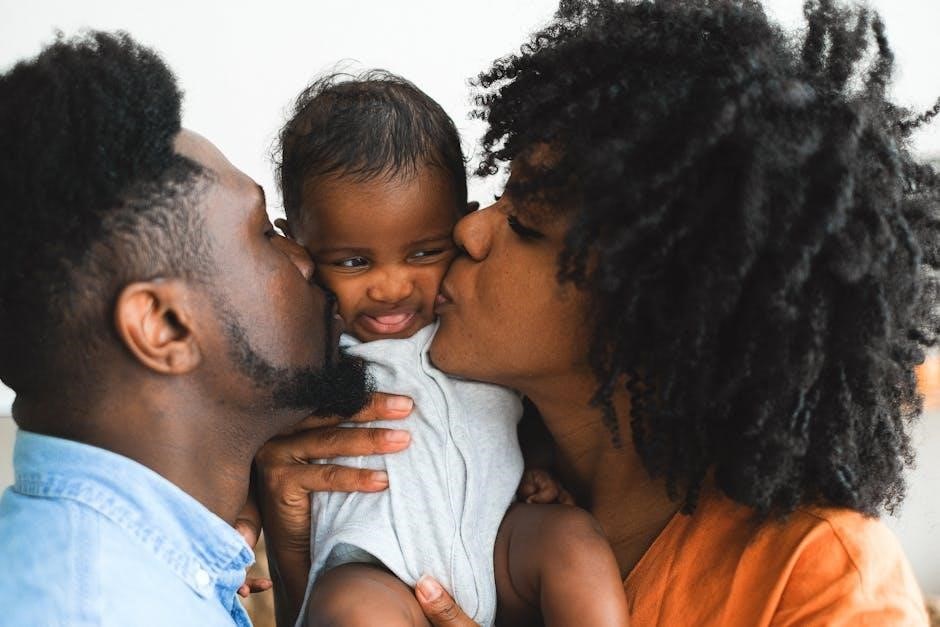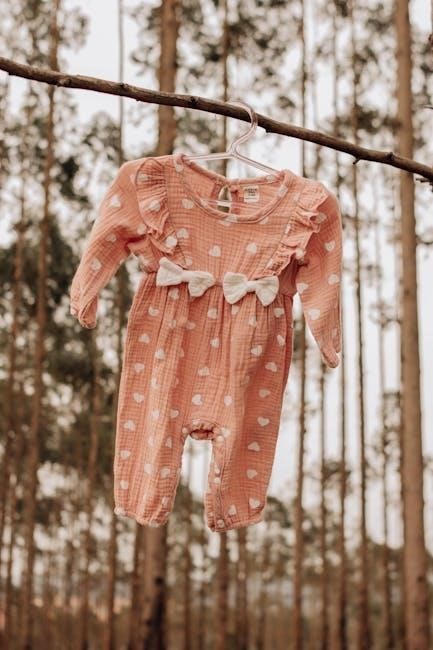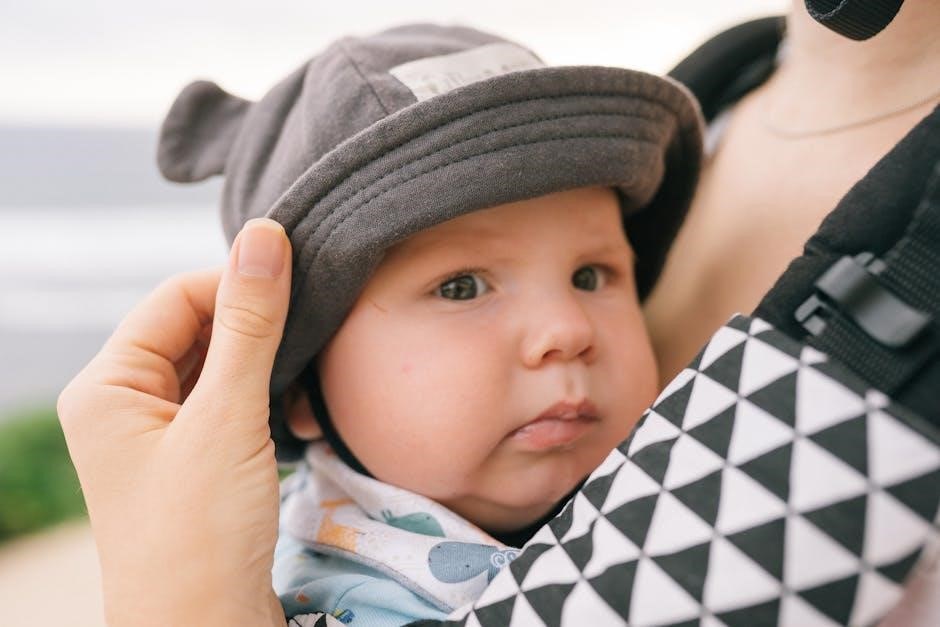Baby romper patterns are a popular choice for sewists, offering an adorable and easy-to-make garment․ These patterns are versatile, suitable for various fabrics and sizes, and often include customizable details like ruffles, making them perfect for any skill level․
1․1 What is a Baby Romper?
A baby romper is a one-piece garment that combines a shirt and shorts or pants, extending to the hips or knees․ It’s designed for comfort and ease, often featuring snap closures for simple diaper changes․ Rompers are perfect for everyday wear, special occasions, or seasonal outfits, and they can be customized with ruffles, embroidery, or other embellishments to suit any style․
1․2 Benefits of Using a Free PDF Pattern
Using a free PDF pattern for a baby romper offers convenience and cost-effectiveness․ These patterns are easily downloadable, allowing you to print and use them immediately․ They often include multiple sizes and customizable options, making it easy to create a romper that fits perfectly․ Many free patterns also provide step-by-step instructions, ideal for beginners․ Additionally, they allow for creative freedom to add embellishments or use different fabrics, ensuring a unique and personalized garment․
1․3 Why Choose a Baby Romper Pattern?
Baby romper patterns are a timeless and practical choice for little ones, offering comfort and ease of movement․ They are ideal for beginners due to their simple construction and forgiving fit․ Romper patterns also allow for creative expression, with options to customize using various fabrics, colors, and embellishments․ Perfect for everyday wear or special occasions, a baby romper is both stylish and functional, making it a favorite for parents and sewists alike․
Materials and Tools Needed
To create a baby romper, you’ll need fabric, notions like snaps or buttons, and basic sewing tools such as scissors, a sewing machine, and an iron for pressing seams․
2․1 Fabric Requirements
Choose soft, breathable fabrics like cotton, linen, or bamboo for comfort․ Knit fabrics offer stretch, while woven fabrics provide structure․ Consider seasonal needs: lightweight fabrics for summer and warmer options like flannel for winter․ Ensure the fabric is suitable for the pattern’s design and your baby’s comfort․ Always pre-wash fabric before cutting to prevent shrinkage and ensure accurate sizing․ Opt for prints or solids to match your desired style․
2․2 Notions and Supplies
Essential notions include thread, buttons, snaps, or zippers for closure․ Add elastic for waistbands or leg openings if required․ Use a seam ripper, scissors, and pins for accurate cutting and sewing․ Measuring tapes and sewing gauges ensure precise measurements․ Optional notions like ruffles or appliques can enhance the design․ Always check the pattern for specific requirements and use high-quality, baby-safe materials for durability and comfort․
2․3 Essential Sewing Tools
A sewing machine and serger are key for constructing a baby romper․ Use sharp scissors or a rotary cutter for precise fabric cutting․ A seam ripper helps correct mistakes․ Measuring tools like a sewing gauge or ruler ensure accuracy․ Iron and ironing board are crucial for pressing seams․ Pins and clips keep fabric in place during sewing․ Optional tools include a walking foot for knits or a zipper foot for closures․

Step-by-Step Sewing Instructions
Start by printing and assembling the PDF pattern․ Cut fabric pieces accurately, then sew them together following the guide․ Ensure proper alignment and secure seams for durability․
3․1 Printing and Assembling the Pattern
Start by downloading the free baby romper PDF pattern and printing it at 100% scale․ Ensure the test square matches the specified size for accuracy․ Carefully cut out the pattern pieces and align them according to the guide․ Tape the sections together to form the complete pattern, ensuring proper alignment of edges and markings․ Double-check the fit and adjust if necessary before proceeding to fabric cutting․
3․2 Cutting Out Fabric Pieces
Once the pattern is assembled, lay your fabric flat and smooth․ Use the pattern pieces to trace or cut out the fabric, ensuring accurate alignment with grain lines․ Cut carefully, following the pattern’s markings for symmetry․ Use scissors or a rotary cutter for clean edges․ Consider layering fabric for efficiency and double-check all pieces before proceeding to ensure nothing is missed․ Accuracy is key for a professional finish․
3․3 Constructing the Romper
Begin by sewing the major components together, such as the front and back pieces․ Attach sleeves or straps according to the pattern instructions․ Next, add any closures like snaps or buttons․ Carefully press seams to ensure a smooth finish․ Once the main structure is complete, attach any additional features like ruffles or pockets․ Finally, align all pieces for a final assembly, ensuring proper fit and alignment for a polished, professional result․
Customizing Your Baby Romper
Add personal touches like ruffles, bows, or embroidery․ Mix fabrics for a unique look, or adjust sizes for growth․ Make it special with every stitch!
4․1 Adding Ruffles or Embellishments
Add ruffles or embellishments to give your baby romper a personalized touch․ Ruffles can be sewn along the neckline, sleeves, or hem for a delicate, feminine look․ Embellishments like bows, buttons, or appliques add charm․ Choose lightweight fabrics for ruffles to ensure comfort․ Follow pattern instructions or use tutorials for guidance․ These details make the romper unique and adorable, perfect for special occasions or everyday wear․
4․2 Incorporating Different Fabrics
Incorporating different fabrics into your baby romper adds texture and visual interest․ Mix lightweight fabrics like cotton voile or linen for a soft, breathable look․ Pair chambray with quilting cotton for a modern contrast․ Layering fabrics like lace or eyelet can create a delicate, feminine touch․ Ensure fabrics complement each other in weight and drape for a polished finish․ This technique allows for endless creativity, making each romper uniquely stylish and personalized․
4․3 Adjusting Sizes for Perfect Fit
Ensure a perfect fit by adjusting the pattern to your baby’s measurements․ Measure chest, waist, and length accurately․ Use size charts to select the best fit․ Patterns often include multiple sizes, allowing for growth adjustments․ Make muslins to test fit before cutting final fabric․ Small tweaks like lengthening or shortening hems can customize the romper to your baby’s needs, ensuring comfort and a flattering silhouette․ This step ensures the romper grows with your baby․

Tips for Beginners
Start with simple patterns and choose fabrics like woven cotton for ease․ Print patterns accurately and follow instructions step-by-step․ Practice on muslin before sewing final fabric․
5․1 Choosing the Right Fabric
For a baby romper, select fabrics that are soft, breathable, and durable․ Cotton is ideal for beginners, offering ease of sewing and comfort for babies․ Stretch knits, like jersey, provide flexibility and are great for active babies․ Consider seasonal fabrics—lightweight options like voile or linen for summer, and warmer fabrics like flannel for colder months․ Always pre-wash fabric to ensure shrinkage is accounted for before sewing․
5․2 Understanding Pattern Markings
Understanding pattern markings is crucial for accurate sewing․ Look for symbols like grain lines, which indicate fabric alignment, and notches that help match pieces․ Patterns may include dots for gathering or circles for button placements․ Familiarize yourself with these marks to ensure proper construction․ Always follow the pattern’s guide for clarity, as misinterpreting symbols can lead to fit issues․ Practice on scrap fabric to build confidence․
5․3 Common Mistakes to Avoid
Common mistakes when sewing baby rompers include incorrect pattern alignment, forgetting to leave seam allowances, and mismatched fabric pieces․ Ensure accurate cutting by using weights or pins․ Avoid stretching fabric while sewing, especially with knits․ Double-check measurements and pattern instructions to prevent errors․ Pre-washing fabric is essential to avoid post-sew shrinkage․ Take your time and don’t rush through steps to achieve a professional finish․ Attention to detail ensures a well-made romper․

Sizing and Fit
Accurate measurements and size charts ensure a perfect fit for baby rompers․ Choose patterns with adjustable features like straps or waistbands for flexibility and comfort․
6․1 Understanding Size Charts
Size charts are essential for ensuring the perfect fit in baby rompers․ They typically include measurements for chest, waist, and length, allowing you to choose the right size based on your baby’s dimensions․ Many free PDF patterns offer multiple sizes, from newborn to 12 months, with some extending up to 24 months․ Always measure your baby accurately and cross-reference with the chart to avoid sizing errors․
Patterns often include a “finished garment measurements” section, which shows the romper’s dimensions after sewing․ This helps in achieving the desired fit, whether snug or roomy․ Some patterns also offer adjustable features like straps or elastic waistbands, which enhance flexibility and comfort․ Understanding size charts ensures your romper is both functional and adorable, making it a joy to sew and wear․
6․2 Measuring for the Perfect Fit
Measuring your baby accurately is crucial for a well-fitting romper․ Use a flexible tape measure to take chest, waist, and length measurements․ For the chest, measure around the widest point under the arms․ The waist is typically measured at the narrowest part of the torso․ Ensure the baby is lying down for accurate chest and waist measurements․ Consider the romper’s design, such as diaper-friendly features, to ensure comfort and practicality․ Always double-check your measurements to avoid sizing issues․
6․3 Adjusting the Pattern for Growth
Adjusting the pattern for growth ensures your baby romper remains comfortable as your little one grows․ Consider adding a bit of extra length to the legs and arms․ Use adjustable straps for a customizable fit․ Incorporate snap closures for easy adjustments․ Opt for stretchy fabrics to accommodate growth naturally․ Ensure the pattern allows for a roomy fit while maintaining the overall design aesthetic;
Fabric Selection Guide
Choose breathable, soft fabrics like cotton or knits for comfort․ Consider seasonal options: lightweight for summer, warmer for winter․ Mix patterns and solids for a stylish look․
7․1 Best Fabrics for Romper
The best fabrics for baby rompers are soft, breathable, and durable․ Cotton is ideal for everyday wear due to its natural texture and comfort․ Knit fabrics, like jersey or interlock, offer stretch for ease of movement․ Bamboo fabric is eco-friendly and moisture-wicking, perfect for sensitive skin․ For a dressier look, lightweight linen or rayon blends can be used․ Always pre-wash fabrics to ensure softness and shrinkage control before sewing․
7․2 Seasonal Fabric Choices
Choose fabrics according to the season for optimal comfort and style․ For summer, lightweight cotton, linen, or rayon are ideal for breathability․ In winter, opt for warm flannel, fleece, or thick knits․ For spring and autumn, soft corduroy or bamboo blends work well․ Consider festive patterns like holiday prints for special occasions․ Seasonal fabric choices ensure your baby stays comfortable and stylish year-round, adapting to varying weather conditions while maintaining a cute appearance․
7․3 Mixing and Matching Fabrics
Mixing and matching fabrics adds creativity to your baby romper․ Combine a vibrant main fabric with contrasting ruffles or pockets for a playful look․ For a cohesive design, ensure patterns and solids complement each other․ Experiment with textures, like pairing smooth cotton with soft lace․ Always pre-wash fabrics to ensure compatibility․ This technique allows for unique, personalized rompers that stand out while maintaining comfort and style for your little one․

Patterns for Special Occasions
Discover adorable baby romper patterns for holidays, birthdays, or seasonal events․ Choose from themed designs like Christmas, Halloween, or summer styles to create memorable outfits for your baby․
8․1 Holiday-Themed Romper Patterns
Holiday-themed romper patterns add festive charm to your baby’s wardrobe․ From Christmas trees to Easter bunnies, these designs feature seasonal motifs․ Perfect for celebrations, they often include ruffles, snap closures, and adjustable straps․ Many free PDF patterns offer customizable options, allowing you to create unique outfits for holidays like Halloween, Thanksgiving, or the 4th of July․ Sewists of all levels can enjoy crafting these adorable, themed rompers for special occasions․
8․2 Romper Patterns for Girls
Romper patterns for girls often feature delicate designs, ruffles, and bows, perfect for creating adorable outfits․ Many free PDF patterns include options for floral fabrics, lace trim, or embroidery․ These patterns are customizable, allowing you to add embellishments like ribbons or appliques․ Ideal for spring and summer, they offer a feminine touch with adjustable straps and snap closures for easy changes․ Sewists can craft beautiful, one-of-a-kind rompers for girls using these detailed and versatile patterns․
8․3 Romper Patterns for Boys
Romper patterns for boys are designed with a focus on comfort and practicality, often featuring bold colors and playful themes like cars or animals․ Free PDF patterns typically include options for button-up closures and adjustable waistbands․ These designs are perfect for casual outings and can be made from durable fabrics like cotton․ With easy-to-follow instructions, sewists can create stylish, functional rompers tailored for active boys, ensuring a perfect fit and timeless appeal․
Troubleshooting Common Issues
Common issues include pattern alignment, fit problems, and fabric challenges․ Adjusting patterns, checking measurements, and pre-treating fabrics can resolve these issues, ensuring a polished finish for baby rompers․
9․1 Fixing Pattern Alignment
Accurate pattern alignment is crucial for a professional finish․ Ensure the PDF is printed at 100% scale and the test square matches․ Common issues include mismatched seams or crooked designs․ To fix, use reference lines on the pattern, double-check fabric grain alignment, and ensure pieces are taped together correctly․ If misaligned, recut or adjust seams carefully․ Starting with a muslin prototype can help identify and resolve alignment errors before cutting final fabric․
9․2 Resolving Fit Problems
Fitting issues in baby rompers often arise from incorrect sizing or fabric choice․ Start by comparing measurements to the size chart․ If too tight, adjust seam allowances or size up․ For looseness, reduce fabric or take in seams․ Consider adding elastic for a snug fit․ Test adjustments on a muslin prototype before final sewing to ensure comfort and proper movement for the baby․ Always check for ease in the pattern to avoid restrictive garments․
9․3 Dealing with Fabric Challenges
Fabric challenges, such as stretching or slippage, can affect the romper’s stability․ Use stabilizers like interfacing for knits to prevent distortion․ Pre-wash fabrics to avoid shrinkage post-sewing․ For delicate materials, serge or zigzag seams to prevent fraying․ Ensure accurate grain alignment to maintain fabric integrity․ Test fabric behavior before cutting to anticipate and mitigate potential issues during construction, ensuring a professional finish for the baby romper․
